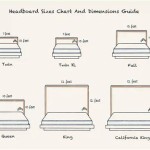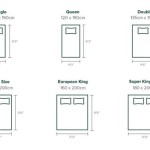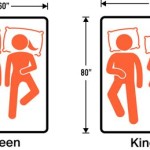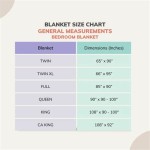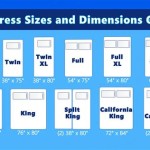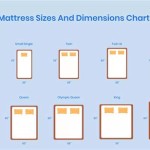How to Determine Your Bed Size
Accurately identifying the size of a bed is essential for various reasons, ranging from purchasing appropriately sized bedding to ensuring the bed frame fits comfortably within a bedroom. Misidentification can lead to frustration and unnecessary expenses. This article presents several methods for determining the dimensions of a bed, enabling individuals to confidently ascertain its size.
The bed size commonly affects decisions on buying new bedsheets, comforters, and even for moving the bed. Knowing the exact dimensions prevents buying ill-fitting beddings. Whether needing to determine the size of an existing bed or verifying measurements of a new purchase, several reliable techniques can be used to ensure accuracy. These methods involve measuring the bed frame and mattress, cross-referencing those measurements with standard size charts, and taking into account variations in manufacturing.
Measuring the Bed Frame
The first step in determining the bed size involves measuring the bed frame. This approach provides valuable information, particularly if the mattress has been disassociated from the frame. The key is to meticulously measure the interior dimensions of the frame, as this interior space dictates the size of the mattress it is designed to accommodate. Measurements should be taken in inches or centimeters for precise results.
To begin, use a measuring tape to measure the length and width of the interior of the bed frame. Run the tape measure along the inside edges of the frame, ensuring it is straight and taut. Record the measurements carefully. Repeat the process at multiple points to account for any potential irregularities in the frame's construction. For example, measure the length at the head of the bed, the foot of the bed, and in the middle. Similarly, measure the width at the top, bottom, and center. If discrepancies exist, use the average of the measurements to determine the overall size.
It is important to note that some bed frames may have slight variations in size depending on the manufacturer or style. For instance, platform beds may have a lip or edge that extends slightly beyond the mattress. In these cases, focus on the interior dimensions where the mattress will rest. Measure from the inside edge of one side rail to the inside edge of the other side rail for the width and from the inside edge of the headboard to the inside edge of the footboard for the length. This will provide an accurate estimate of the required mattress size.
Once the interior dimensions are known, these measurements can be compared against standard bed size charts to identify the likely bed size. These charts provide the typical dimensions associated with twin, full, queen, king, and California king beds. While minor variations may exist, this comparison provides a reliable indication of the bed's size category.
Measuring the Mattress
Measuring the mattress itself offers another approach to determining bed size. This method is particularly useful if the mattress is readily accessible and not obscured by bedding or a bed frame. However, it is crucial to understand that mattress dimensions can vary slightly among manufacturers. Consequently, multiple measurements should be taken to ensure accuracy.
Remove all bedding, including sheets, blankets, and mattress protectors, to expose the bare mattress. Place the mattress on a flat surface if possible, or ensure it is laying flat on the bed frame. Using a measuring tape, measure the length and width of the mattress. Ensure the tape measure is straight and taut to achieve precise readings. Measure from edge to edge, avoiding any rounding or estimation.
As with measuring the bed frame, measure the mattress at multiple points along its length and width. Check the length at the top, bottom, and center of the mattress, and check the width on both sides and in the middle. This will help identify any potential inconsistencies in the mattress's shape or construction. If differences are observed, average the measurements to determine the overall dimensions. Consistent measurements will give more confidence in the accuracy of the determined bed size.
After obtaining the length and width measurements, compare them with standard bed size charts. These charts list the typical dimensions for various bed sizes, allowing for a straightforward comparison. Keep in mind that a slight discrepancy of an inch or two is not uncommon due to manufacturing tolerances, but significant deviations may suggest a non-standard size or a measurement error. If unsure, a second measurement should be taken by another person to confirm the results.
Furthermore, observing the thickness of the mattress can sometimes offer clues about its type and intended use. Thin mattresses are typically used for bunk beds or daybeds, while thicker mattresses are common for standard beds. However, thickness alone is not a reliable indicator of bed size, and should be combined with length and width measurements for an accurate assessment.
Consulting Standard Bed Size Charts
Standard bed size charts serve as a crucial reference point for determining bed size. These charts provide the typical dimensions associated with various bed sizes, including twin, twin XL, full, queen, king, and California king. While slight variations may exist among manufacturers, these charts offer a reliable baseline for comparison. Consulting multiple charts from different sources can further enhance accuracy, as minor discrepancies may be observed.
Standard charts typically list the dimensions in inches, though some may also include metric equivalents. For example, a standard twin bed is usually around 38 inches wide and 75 inches long. A full bed is about 53 inches wide and 75 inches long. Queen beds measure approximately 60 inches wide and 80 inches long, while king beds are roughly 76 inches wide and 80 inches long. California king beds, on the other hand, are typically 72 inches wide and 84 inches long.
When comparing measured dimensions to these charts, it is important to allow for minor variations. A difference of an inch or two is generally acceptable, as manufacturing processes inevitably introduce some degree of tolerance. However, significant deviations may indicate that the bed is a non-standard size or that the measurements were taken incorrectly. In such cases, re-measuring the bed frame or mattress is advisable. In addition, the style of the mattress should be considered. Some mattresses, such as pillow-top models may make it difficult to get exact measurements.
Furthermore, it is important to be aware of regional differences in bed sizes. In some countries, bed sizes may vary from the standards used in the United States. Therefore, when purchasing a bed or bedding from a foreign manufacturer, it is important to verify the dimensions carefully. Comparison to multiple charts, from multiple sources, can help to account for this discrepancy.
Online retailers and bedding stores often provide detailed bed size charts on their websites. These charts may include additional information, such as recommended room sizes and bedding dimensions for each bed size. Consulting these resources can provide a comprehensive understanding of the nuances associated with different bed sizes, facilitating informed purchasing decisions.
In addition to standard bed sizes, there are also less common sizes such as twin XL and Olympic queen. A twin XL bed is the same width as a standard twin but is longer. An Olympic queen bed is wider than a standard queen but the same length. Familiarizing with these uncommon sizes helps to avoid confusion when determining the size of an unfamiliar bed.
Considering Manufacturer Variations
While standard bed size charts provide a valuable guideline, it is important to acknowledge that manufacturers can introduce slight variations in their products. These variations may stem from differences in design, materials, or manufacturing processes. Consequently, relying solely on standard dimensions may lead to inaccuracies. Taking manufacturer variations into account can help refine the assessment of bed size.
Before purchasing bedding or bed frames, consult the manufacturer's specifications for the bed or mattress. Many manufacturers provide detailed information about their products, including precise dimensions. This information can be found on their websites, product manuals, or packaging. Comparing the manufacturer's specifications with the standard size chart will reveal any deviations and ensure a better fit.
It is important to note that some manufacturers may use proprietary sizing standards. This can be particularly true for imported beds or mattresses. Proprietary sizing can be difficult to identify without consulting the manufacturer's specifications. When dealing with an unfamiliar brand or model, it is always best to err on the side of caution and verify the dimensions directly with the manufacturer.
Also, materials matter. Soft-sided beds may compress or expand, making it difficult to get an exact measurement. The interior dimensions of soft-sided bed frames might also not follow standard sizes. This is true for waterbeds and similar designs. Taking measurements on such beds should include multiple attempts in case the material shifts during the process.
In addition to dimension variations, manufacturers may also differ in their construction methods, which can impact the overall size and shape of the bed. For example, some mattresses may have reinforced edges or pillow-top layers that add to their overall thickness or width. These features can affect the fit of bedding and bed frames. Consider these features when measuring the bed and when selecting bedding and bed frames.

How To Measure Bed Size 10 Steps With Pictures Wikihow

How To Measure A Mattress 7 Steps With Pictures Wikihow

A Guide To Choosing The Right Bed Size
Bed Measurement Guide For Your New Storage Blog Furl

How To Measure Bed Size 10 Steps With Pictures Wikihow

Bed Sheet Ing Guide Designer Living

Mattress Sizes What Size Room You Should Have Them In The Sleep Judge

Bed Sizes And Dimensions Choosing The Right Size Mattress

Know Your Bed Linens Sizing Trilogy Luxury Training
Mattress Size Chart And Bed Dimensions Guide 2024


